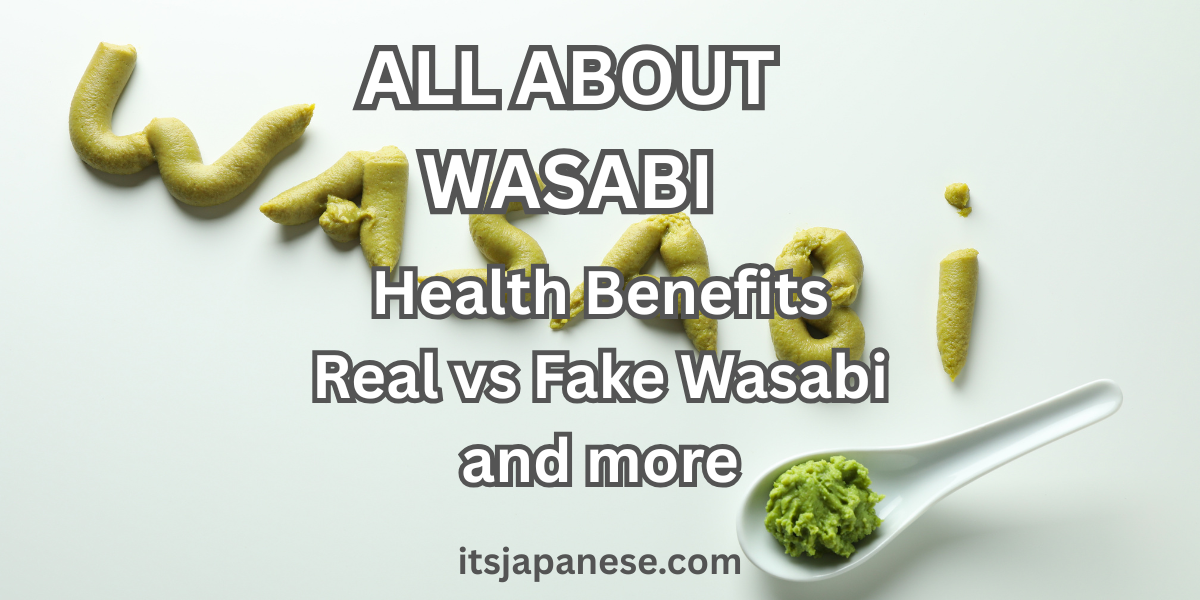What’s the deal with wasabI?
What’s it made it of? Is it healthy? And what’s the difference between real and fake wasabi?
This quick guide answers all.
Wasabi Explained
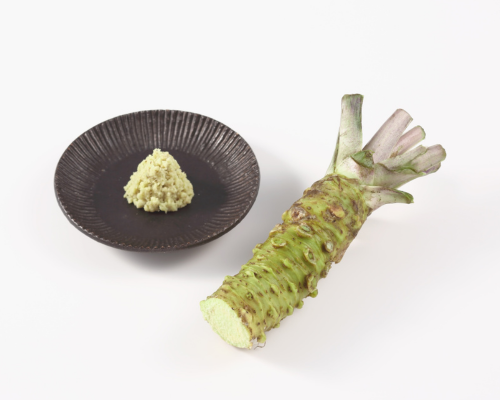
Wasabi, also known as Japanese horseradish, is often found grated into a green paste as a condiment.
The flavor can be sharp, pungent, and spicy.
Compared to the spice of a chili pepper, it is a spice that you feel in your nose and doesn’t linger.
If you’ve been to a Japanese restaurant, you’ve most likely encountered this condiment with soy sauce.
It’s also a popular snack flavor and an iconic part of Japanese cuisine.
And hey, if you want some wasabi for yourself, you can definitely get some on Amazon (click below)
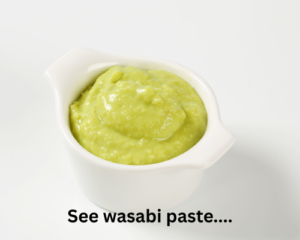 click here to learn more on amazon |
What is Wasabi Made Of?
Wasabi is made from the root-like stem of the Wasabia Japonica plant.
This semi-aquatic plant can be found around Japan in cool mountain streams.
The plant is in the same family as horseradish, mustard, and cabbage.
However, one interesting thing is that most wasabi served at restaurants is not real wasabi.
It is usually made from horseradish, mustard, and green food coloring to look similar to real wasabi.
Real wasabi is difficult to find and extremely expensive.
What Does Wasabi Taste Like?
The taste of wasabi is sharp with a kick, similar to the sensation when you eat horseradish and mustard.
When you have a lot of wasabi, you can feel it in your nose, and your eyes might start to tear.
Compared to a chili pepper, it doesn’t linger on your tongue, and it dissipates very quickly.
The flavor is herbal with a slight sweet taste.
Why is Wasabi So Spicy?
The spiciness of wasabi is due to a chemical compound called isothiocyanate.
This is formed when the plant’s cells are broken, which is triggered by being grated or crushed.
The isothiocyanates are known for stimulating nerve endings in the nose and sinuses.
This is different from capsaicin, which is found in chili peppers that target the mouth.
The spiciness of wasabi can be intense at first, but tends to quickly go away.
Is Wasabi Expensive?
Yes, real wasabi (as opposed to fake wasabi) is expensive, especially if you try to get it outside of Japan.
The wasabi plant can only grow in specific conditions such as cool, clean water, and a lot of care.
The rhizome, or root-like, part is very delicate and requires careful handling to maintain its flavor.
Fresh wasabi can cost between $100 to $200 per kilogram, depending on the quality.
The wasabi you most likely encounter when you get take-away sushi or at a low to mid-range sushi restaurant is a fake wasabi that uses horseradish, mustard, and food coloring.
This fake wasabi is typically sold as a powder or as a pre-made paste. We’ll talk more about it below.
Health Benefits of Wasabi
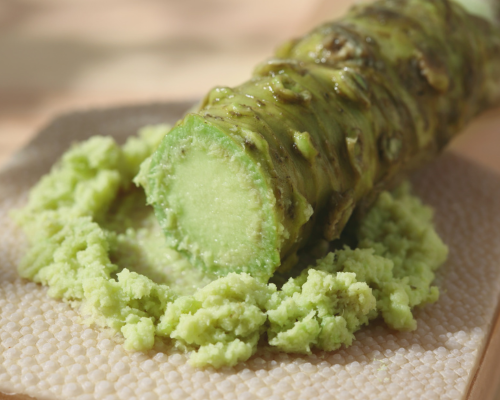
The isothiocyanates in wasabi offer several health benefits due to their antimicrobial and anti-inflammatory properties.
They can help with things like infections, inflammation, and promote digestion.
- Antioxidants: The antioxidants inside of wasabi can help to fight and potentially lower the risk of chronic diseases like heart disease.
- Anti-inflammatory: The compounds found in wasabi can be anti-inflammatory and benefit inflammatory conditions.
- Digestive Benefits: The spiciness inside the wasabi could help promote digestive enzymes and improve digestion.
- Antimicrobial: It is said that the antimicrobial effects of wasabi, due to its essential oils, are one of the reasons why it is often served alongside fresh fish.
- Detoxifying: Some studies suggest that wasabi can also have detoxifying effects, which can help remove toxins from the liver.
How is Wasabi Used in Japanese Cuisine
Traditionally, wasabi is often paired with soy sauce and sushi or sashimi, but you can also find modern snacks incorporating wasabi flavors.
The following are some common ways you’ll find wasabi:
- Sashimi & Fresh Seafood: If you order a platter of sashimi, you’ll most likely see some wasabi served alongside it. You can add some to your fish and dip it into soy sauce. The spiciness of the wasabi can pair well with fresh fish!
- Sushi: In sushi, you’ll find wasabi underneath the fish on top of rice in traditional Japanese restaurants. If you don’t like wasabi, you can ask for the sushi without wasabi.
- Noodles: You’ll sometimes find cold noodles served with some wasabi as a condiment.
- Tempura: The fried oiliness of tempura can pair well with wasabi to freshen up the flavor!
- Mixed with other condiments: You can find wasabi dressings and also mayonnaise mixed with wasabi as a condiment.
- Snacks: Outside of Japan, you might be familiar with wasabi pea snacks. In Japan, they also have wasabi potato chips, and you can even find wasabi ice cream!
Difference Between Real & Fake Wasabi
The main difference between real & fake wasabi is the ingredients and flavor.
Most restaurants outside of Japan, as well as low to mid-range restaurants in Japan, serve fake wasabi due to its lower cost and ease of handling.
Chances are, you’ve mostly encountered fake wasabi all your like.
So, what’s the difference between the two?
Real Wasabi
If it is real wasabi, it should come from the Wasabia Japonica plant, as mentioned earlier.
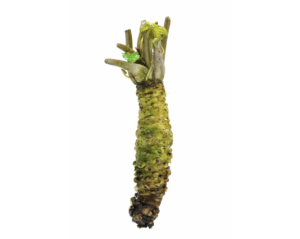
It is only found in clean, cool streams in the mountains and requires a lot of care to grow.
The price point of the real wasabi is about $100 – $200 (USD) per kilogram.
The flavor of the real wasabi is milder, but still has a nice spice that horseradish and mustard can also have.
Because it is typically freshly grated before serving, the texture of the wasabi is also more gritty, and it has a unique freshness.
Fake Wasabi:
On the other hand, fake wasabi is often a blend of horseradish, mustard powder, and food coloring.
While it may look and taste similar at first, with the same green color and sharp heat, it usually delivers a more overpowering kick and lacks the complexity and refined flavor of real wasabi.
Since it’s commonly sold in tubes or powder form, its texture tends to be smoother or stickier compared to freshly grated authentic wasabi.
It’s also significantly more affordable, which is why it’s widely used outside of Japan.
Back to You
Now you know a bit about wasabi.
If you’re interested, of course you can always get some on Amazon.
Question for you is… have you been eating real or fake wasabi?
